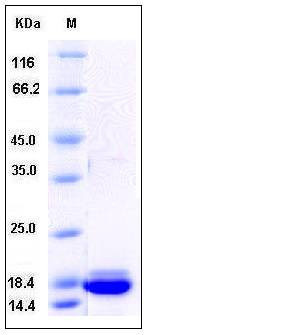Mouse Peroxiredoxin 5 / PRDX5 Protein (His Tag)
AOEB166,AOPP,Pmp20,Prdx6,PrxV
- 100ug (NPP3443) Please inquiry
| Catalog Number | P50551-M07E |
|---|---|
| Organism Species | Mouse |
| Host | E. coli |
| Synonyms | AOEB166,AOPP,Pmp20,Prdx6,PrxV |
| Molecular Weight | The recombinant mouse PRDX5 consisting of 173 amino acids and migrates as an approximately 18.5 kDa band in SDS-PAGE under reducing conditions as predicted. |
| predicted N | Met |
| SDS-PAGE |  |
| Purity | > 92 % as determined by SDS-PAGE |
| Protein Construction | A DNA sequence encoding the mouse PRDX5 (mitochondrial) (P99029-1) (Met 49-Leu 210) was expressed, with a polyhistide tag at the N-terminus. |
| Bio-activity | Measured by its ability to reduce H2O2. The specific activity is > 100 pmoles/min/μg. |
| Research Area | Neuroscience |Neurology process |Circadian Rhythm |Receptors in Circadian Rhythm |Associated Proteins |
| Formulation | Lyophilized from sterile PBS, pH 7.5 1. Normally 5 % - 8 % trehalose and mannitol are added as protectants before lyophilization. Specific concentrations are included in the hardcopy of COA. |
| Background | Peroxiredoxin-5, also known as Alu corepressor 1, Antioxidant enzyme B166, Liver tissue 2D-page spot 71B, Peroxisomal antioxidant enzyme, Thioredoxin peroxidase PMP20, Thioredoxin reductase, PRDX5 and ACR1, is cytoplasm protein which belongs to the?peroxiredoxin 2 family. Peroxiredoxin-5 / PRDX5 reduces hydrogen peroxide and alkyl hydroperoxides with reducing equivalents provided through the thioredoxin system. Peroxiredoxin-5 / PRDX5 is involved in intracellular redox signaling. The Peroxiredoxins / Prx are a family of 25 kDa peroxidases that can reduce H2O2 using an electron from thioredoxin (Trx) or other substances. The mammalian Peroxiredoxins / Prx family is divided into six groups ( PRDX1,PRDX2, PRDX3, PRDX4, PRDX5, PRDX6 ) on the basis of homology of amino acid sequences. They are located in the cytosol and play a role in the cell signaling system. All six mammalian peroxiredoxins are expressed in the lung. Peroxiredoxins / Prx is overexpressed in breast cancer tissues to a great extent suggesting that Peroxiredoxins / Prx has a proliferative effect and may be related to cancer development or progression. |
| Reference |
